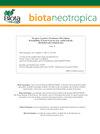The butterflies (Lepidoptera, Papilionoidea) of the Parque Estadual Intervales and surroundings, São Paulo, Brazil
IF 1.2
4区 环境科学与生态学
Q3 BIODIVERSITY CONSERVATION
引用次数: 0
Abstract
Abstract The Global South has witnessed increasing sampling of its immense biological diversity during the past century. However, the diversity of many regions remains unknown, even at pristine and highly threatened places, such as in the Atlantic Forest; and for bioindicator, umbrella, and flagship groups. The present study reports the first butterfly list of the Parque Estadual Intervales, São Paulo, Brazil and surroundings, a key protected area in the last massive continuous of the Atlantic Forest. We compiled data from museums and four years of field work, under three sampling methods. We also aimed at providing resources to support conservation efforts by analyzing 27 years of climatic data (detailed in the Supplementary Material, in English and in Portuguese), discussing our results also for non-academics, and producing scientific outreach and educational material. A companion article dealt with the experiences of science outreach and capacity development, and illustrated the butterfly catalogue of the species sampled in the park. We found 312 species that sum to 2,139 records. The museum had 229 species (432 records), and we sampled 142 species (1,682 individuals), in a total effort of 36,679 sampling hours (36,432 trap and 247 net and observation hours). The richest families were Nymphalidae (148 species) and Hesperiidae (100 species). Most species were sampled exclusively by active methods (79.8%), but other sources (passive sampling, citizen science, etc.) also found unique records. We found the highest diversity metrics from January to May, and we demonstrated that winter months had less richness and abundance. We illustrated the 20 species common to all regions, and listed those that were found more than seven months in the year, as well as the most abundant species in trap sampling, with forest dwellers as well as species common to open and fragmented areas. The dominant species in our trap datasets was the iridescent white morpho, Morpho epistrophus (Fabricius, 1796), and we suggest it to become the park butterfly mascot.巴西圣保罗公园内的蝴蝶(鳞翅目,凤蝶总科)
在过去的一个世纪里,全球南方国家对其巨大的生物多样性进行了越来越多的采样。然而,许多地区的多样性仍然未知,即使是在原始和高度受威胁的地方,如大西洋森林;对于生物指示剂,保护伞和旗舰组。本研究报告了巴西圣保罗及其周边地区的帕克埃斯塔瓦莱(Parque Estadual Intervales)及其周边地区的第一个蝴蝶名单,该地区是大西洋森林最后一个大规模连续的关键保护区。我们收集了来自博物馆和四年实地工作的数据,采用了三种抽样方法。我们还旨在通过分析27年的气候数据(详见补充材料,英文和葡萄牙文),为非学术界讨论我们的结果,以及制作科学宣传和教育材料,为保护工作提供资源。另一篇文章论述了科学推广和能力发展的经验,并说明了在公园取样的蝴蝶物种目录。我们发现了312个物种,总计2139条记录。共采集标本229种(432份),142种(1682只),总采样时间36679小时(36432个诱捕小时,247个网和观测小时)。最丰富的科为蛱蝶科(148种)和蛱蝶科(100种)。绝大多数物种均为主动采样(79.8%),但其他来源(被动采样、公民科学等)也有独特的记录。我们发现1月至5月的多样性指标最高,并且我们证明了冬季的丰富度和丰度较低。我们列举了所有地区共有的20种,列出了在一年中发现超过7个月的物种,以及在陷阱采样中最丰富的物种,森林居民以及开放和破碎地区常见的物种。捕蝶器资料中的优势种为彩白色大闪蝶(morpho epistrophus, Fabricius, 1796),建议将其作为公园蝴蝶的吉祥物。
本文章由计算机程序翻译,如有差异,请以英文原文为准。
求助全文
约1分钟内获得全文
求助全文
来源期刊

Biota Neotropica
BIODIVERSITY CONSERVATION-
CiteScore
2.90
自引率
16.70%
发文量
0
审稿时长
4-8 weeks
期刊介绍:
BIOTA NEOTROPICA is an electronic, peer-reviewed journal edited by the Program BIOTA/FAPESP: The Virtual Institute of Biodiversity. This journal"s aim is to disseminate the results of original research work, associated or not to the program, concerned with characterization, conservation and sustainable use of biodiversity within the Neotropical region.
Manuscripts are considered on the understanding that their content has not appeared, or will not be submitted, elsewhere in substantially the same form, because once published their copyrights are transferred to BIOTA NEOTROPICA as established in the Copyright Transfer Agreement signed by the author(s).
 求助内容:
求助内容: 应助结果提醒方式:
应助结果提醒方式:


